If the shaking is caused by external factors or physiological reasons, it is enough to eliminate the irritants. If there are additional symptoms, see a specialist.
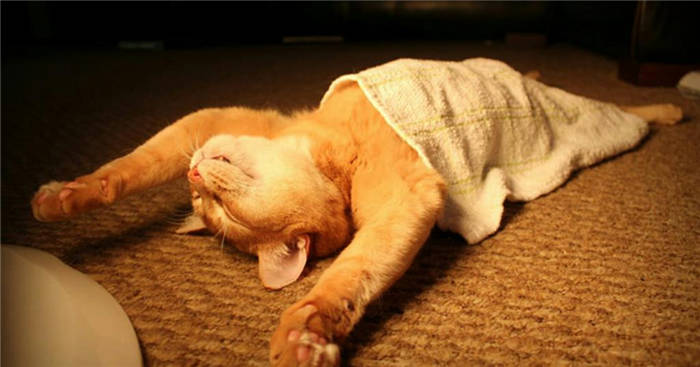
- Why cats twitch in their sleep. When is it worth worrying about?
- When should I be worried?
- What can cause twitching?
- Emotional excitement
- Hormones .
- Why does the kitten shake in her sleep?
- Various diseases of cats
- Hormonal surges in the pet
- Deficiency of vitamins and minerals in the animal's body
- Pain syndrome.
- Factors
- Associated symptomatology
- Subclinical form of panleukopenia
- The latent period of rhinotracheitis
- Calcivirus infection.
- Why the cat trembles
- When to go to the vet
- Physiological reasons
- Overcooling
- Nervous overexcitation
- Period of heat or sexual excitement
- Pathological causes of tremors
- Heatstroke
- Viral and bacterial diseases
- Parasite infestation
- Vitamin and micronutrient deficiencies
- When to go to the vet
- Pain
- Fever
Why cats twitch in their sleep. When is it worth worrying about?
How often have you noticed that your furry pet, which was just sleeping sweetly, suddenly started twitching, snorting, twitching its paws, tail and ears? Is this behavior normal and what causes it? Is it worth worrying about? Let's find out in this article.
Scientists say that cats spend more than half of their lives sleeping. Our furry friends do love to sleep, but have you ever noticed how exactly cats sleep and how their sleep differs from human sleep? Cats are very sensitive sleepers. Cats usually wake up at the slightest rustle. They do not have a transition period from sleep to wakefulness, they are immediately ready for action. This indicates that the animal's brain does not "shut down" completely and is in a state of "reception" even during sleep, reacting to the external environment. In order for the animal's body to fully recover, a deep sleep is necessary. Then the brain can "switch off" from external stimuli and rest.
Although cats are predators in the wild, but they are very small in size, so they run the risk of becoming prey to larger predators. That is why they sleep very sensitively and fall into a deep sleep is not so easy.
Yes, our four-legged friends also dream. There is speculation that cats' dreams are even more dynamic and vivid than those of humans. By the way, it is thanks to the cats, scientists have proved that animals are also immersed in the world of dreams.
To confirm the theory of animal dreaming, scientists removed a small part of the brain, which is responsible for the degree of muscle tension during sleep, in a group of cats. After this procedure, the observed cats, while in a deep sleep state, got up on their paws, walked and behaved as they would in reality when faced with certain situations, such as hunting or stalking prey. The cats not only sensed the outside world, but also made decisions that were natural for them. The experiment confirmed that animals can hear, see and touch dreams.
When should I be worried?
If a cat's paws twitch in its sleep, it is not always a cause for alarm. The pet should be observed. It is necessary to observe not so much in sleep, but at the moment of waking up. The state of the animal can be seen immediately: if the cat is happy, it has a cheerful little hooligan look or vice versa – a mysterious haughty look of an empress, it will stretch and yawn, purr shortly and abruptly.
You should be worried if the cat twitches too often in its sleep. When your pet looks unhappy, tired and lethargic upon awakening, you should contact your veterinarian without delay.
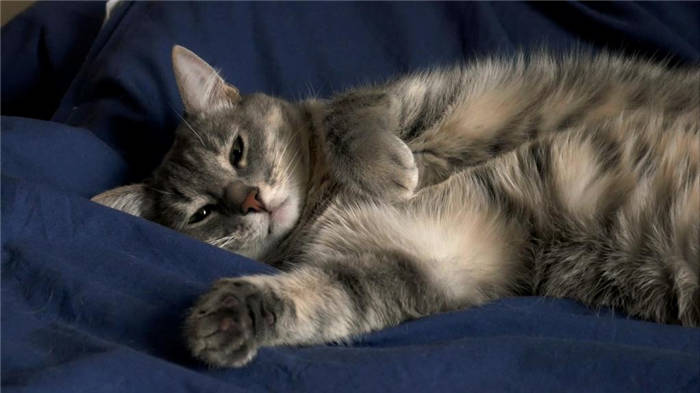
Doctors should also help if the cat jerks its paws in its sleep and then wakes up sweating and with a wet coat. This is a symptom of internal abnormalities in the body, which may be related to hormonal balance or kidney function.
Dry-fed Persians often suffer from kidney failure and urolithiasis. Cats of Persian breeds prone to such ailments always begin to twitch and sweat at first, and only after some time do the characteristic symptoms – changes in urine concentration, color and odor – occur.
When observing a sleeping twitching cat, you should be careful not to wake the cat. This should be done to see if the animal has a cramp – a contraction of the muscle fibers. It is impossible to determine this visually. If your pet's body or paws twitch, you should seek immediate medical attention.
What can cause twitching?
A sleeping cat can twitch for a variety of reasons. In order for the doctor to be able to narrow down the possible sources of this phenomenon, it just requires careful observation of the pet.
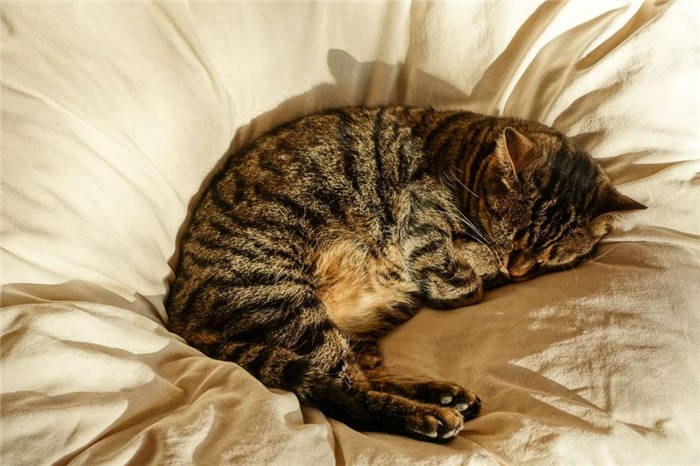
Twitching cat while resting is most often caused by the following:
The presence of muscle spasms, pronounced cramps, and limb twitching is always a signal of serious illness. Unlike the simple twitching and reflexive twitching of the paws, this condition is not caused by a dream or stress.
Emotional excitement
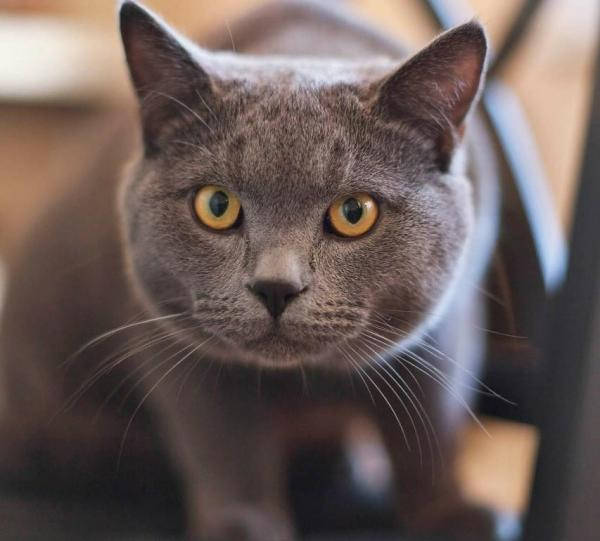
What to do if the cat trembles? First you need to find out the cause, and then take any action. For example, periodic trembling in an animal may occur due to certain emotional states. For example, the cat experienced intense fear, discomfort from the appearance of strangers in the apartment, aggression arose. The appearance of trembling in this case is explained by the tension that grips the animal. At this point, the cat looks like a taut string that is about to burst. It is because of this that she begins to tremble.
It should be noted that not only negative emotions can cause such conditions in the pet. For example, a cat that is experiencing bliss can also periodically shiver. Some owners notice that when they return after work, and the cat is bored, rubbing, purring, it literally shakes with joy. This is the normal state of the animal. Therefore, you should not leave your pet for a long time, if it is so hard to experience the separation from you.
Hormones .
Thinking about why a cat shivers, let's talk about another reason for this condition. These are hormonal storms. During the so-called gulch, when the animal needs to mate, the male may yell furiously, demanding a bride, suffering from tremors that cover his entire body from the tips of his ears to the tail.
This can also be seen in cats. They also often tremble during heat. It is desirable to prevent such anguish of the animal. If you are not planning kittens, then sterilize the pet. After this procedure, the cat will no longer shake for this reason.
Why does the kitten shake in her sleep?
A kitten's CNS is not mature enough to control muscle activity while she sleeps. Young animals shake at night more often than mature animals.
If you cannot determine why a cat shudders, you should suspect pathology. In this case, the cause may be irritation of the nerve endings, as well as severe pain.
Various diseases of cats
If the pet shakes and pulls its hind legs, the cause could be a spinal injury or CNS disorder. A shaking head is a symptom of ear canal pathology. The pet may shake if it has viruses or helminthiasis.
Hormonal surges in the pet
Most often, hormonal surges and tremors are observed during the sex hunt.
This is not a life-threatening condition, but it causes discomfort, so it is better to remove the reproductive organs from the pet.
Deficiency of vitamins and minerals in the animal's body
Minerals and vitamins contribute to the correct transmission of nerve impulses, so if they are deficient, trembling, numbness, etc. may appear. Deficiencies are observed against a background of unbalanced nutrition and digestion disorders.
Pain syndrome.
If the animal shivers when lying down, although the room is warm, it may indicate severe pain. Pets rarely complain of discomfort and behave in a restrained manner, but they cannot control their muscles.
Factors
- Another possible factor in cat tremors could be uncomfortable posture . The cat's muscles and joints can react to being in an uncomfortable position for a long time.
- Equally important could be Stress, previous experience of fright . . Possible causes are excessive activity of the animal during hunting, games. As well as the presence of trauma or contusion.
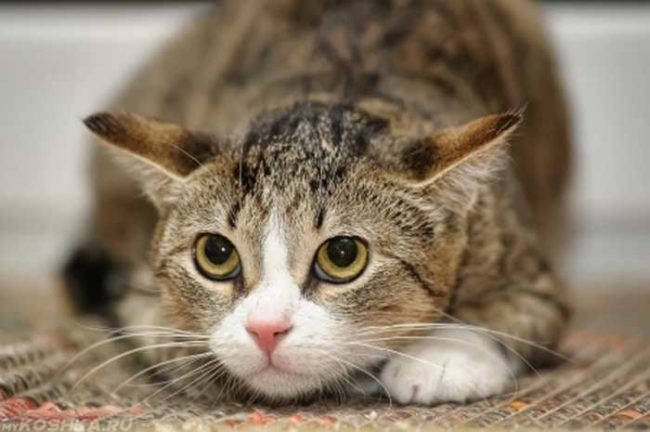
Associated symptomatology
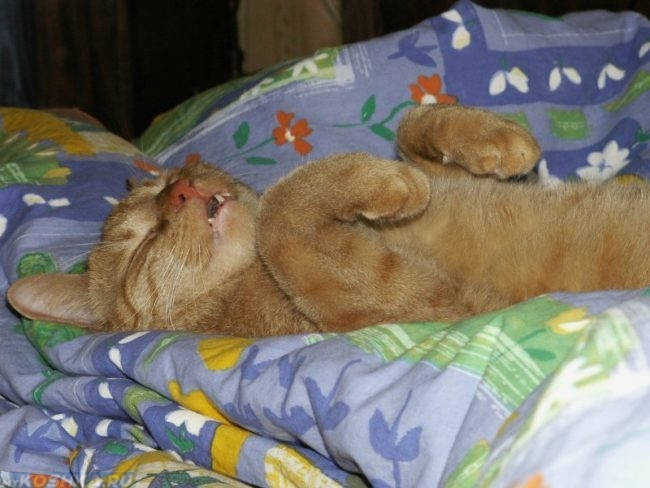
Subclinical form of panleukopenia

In the subclinical form of panleukopenia, the cat becomes lethargic and has a fever.
- The subclinical form of panleukopenia often does not show pronounced symptoms, so timely diagnosis is particularly important.
- The latent period of this disease lasts about ten days, then appears lethargy, fever.
- The cat refuses food and water, while experiencing severe thirst.
- Vomiting, diarrhea, bloating of the abdomen is possible.
The latent period of rhinotracheitis
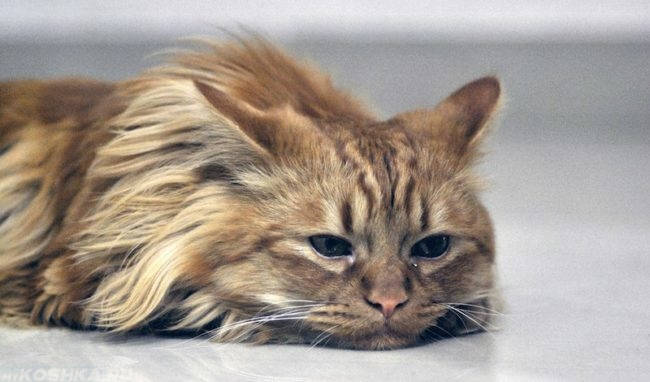
- The first signs are manifested by apathy, decreased appetite, and fever.
- Serum nasal and ocular discharge.
- Eventually turn into purulent-mucous effusions, increased salivation.
- Ulcers develop on the tongue, parenchymatous keratitis sets in.
Calcivirus infection.
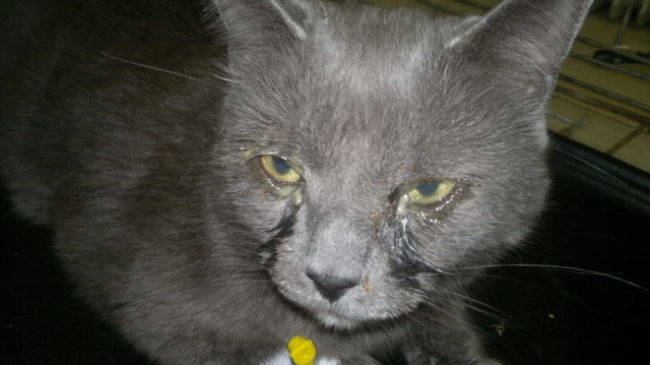
- In healthy and strong animals can proceed in a latent form, and appear only as a slight tremor.
- However, escalating into the chronic stage, it causes irreparable harm to the pet's body.
- It may be expressed by small discharge from the nose and eyes, lameness, apathy, lethargy.
- A slight fluctuation in the body's defenses and the disease progresses to an acute form.
- The danger is the rapid course of the acute form and the development of secondary pathologies.
Why the cat trembles
The causes of tremor can also be dangerous pathological changes and severe diseases. Thus, in the absence of a proper balanced diet of the animal with a pronounced deficiency of necessary vitamin and mineral complexes, degenerative processes develop.
Particularly acute effect on the appearance of shivering in a cat, disorders in the absorption and intake of calcium in the body. Prevent such disorders can be prevented by carefully selecting a diet balanced by all necessary nutrients.
Shivering in a domestic cat can also develop against the background of such a dangerous viral infection as rhinotracheitis. The pathology is accompanied by serious damage to the organs of vision and respiratory tract. Lack of help in the development of the disease, can cause the development of serious complications, in some cases, threatening the normal functioning of the pet.
Another cause of tremor in cats is the presence of internal parasites (helminthiasis).
Shaking in a cat after surgery is a common enough occurrence that it is not an indication of a pathological condition. When the cat shakes after sterilization, it indicates that the body is coming out of anesthesia (deep sleep) and coping with the residual anesthesia.
For the first few hours after the sterilization surgery, shaking in the pet's body is a variant of the norm. If the cat trembles for a long time after spaying (more than 6 hours in a row), you should consult a veterinarian. This is due to the fact that such trembling may indicate the development of internal bleeding.
When to go to the vet
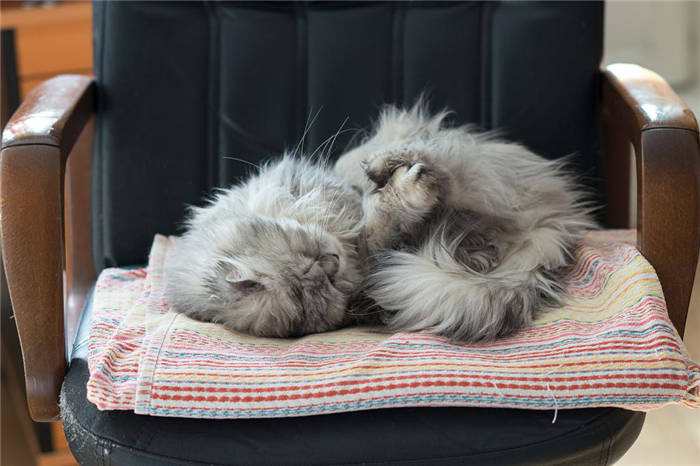
When the cat trembles as a result of a pathological condition and the tremor is not associated with physiological processes, it is necessary to show the pet to a veterinarian. This will allow you to quickly identify the cause of the pathology and prescribe an adequate and appropriate treatment.
Common enough pathologies diagnosed in domestic cats in veterinary medicine are:
- The cat is shaking with small shakes Due to herpesvirus infection or rhinotracheitis virus. In this case, in addition to shaking, the animal has a discharge from the eyes and respiratory tract, there is a characteristic cough and episodes of gastric contents eruption.
- The cat trembles with the whole body In helminthiasis, life-threatening for the animal. Infection with dangerous helminths is accompanied by processes of intoxication of the body, provoking the development of tremors. In some cases, the tremor is not observed in the whole body, but only in the hind or forelimbs.
- Inflammatory process in the bladder.Cystitis causes painful sensations during the act of urination, which leads to tremors of pain. The same symptom appears in domestic cats when they develop urolithiasis.
- Ear diseases – various otitis media and otodectosis, cause itching and discomfort in the cat, provoking tremors (the cat shakes its head). If untreated, the pet may lose its hearing, and in the most dangerous cases, when the eardrum ruptures due to bacterial otitis media, the brain membranes may become infected.
- The appearance of tremors in the head areaThe head tremor may indicate more than just a lesion of the ear canal. As a rule, the cause of head tremor and body tremor may be encephalitis, cerebellar pathology, dangerous skull injuries.
- Tremors in the sacral regionThe tremor may be a signal of spinal abnormalities caused by compression fractures, tumor processes, and deformities in the intervertebral discs.
Physiological reasons
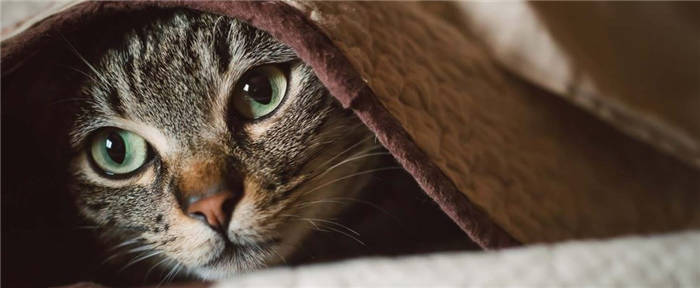
Physiological causes of tremor are most often caused by external factors. If the irritant is removed, the problem may resolve without assistance. However, prolonged or episodic shivering requires a veterinarian's consultation.
Overcooling
Short-haired and bald breeds of cats most often suffer from hypothermia: Sphynxes, Bombinos, Peterbalds. Shivering can also occur after bathing, staying outdoors for a long time or when there are drafts.
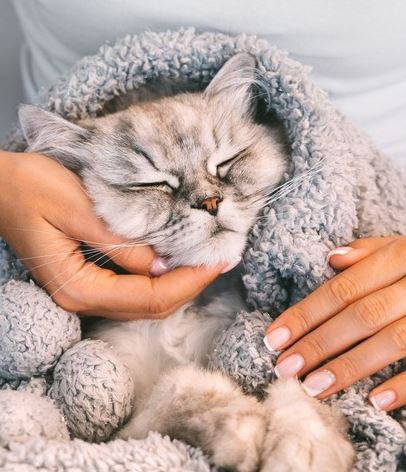
Overcooling is dangerous for the development of colds in the animal.
Shivering in hypothermia is a natural process that does not require veterinarian intervention.
Nervous overexcitation
When overexcited, the whole body may shiver, only the tail, head or paws of the cat. This reaction occurs as a result of a sudden change in the environment, such as when moving or changing ownership. Some animals start shivering at the veterinarian's office or when they meet their kin. Any great stress is the trigger for tremors.
Solving the problem is simple enough: you need to create a comfortable or familiar environment for the cat. When moving, the pet should be given time to adjust. If necessary, sedatives can be used as recommended by your veterinarian.
Period of heat or sexual excitement
In this case, hormones that are produced in the animal in an increased volume are responsible for the occurrence of tremor. Some cats begin to shake when they meet potential rivals.
If the tremor is transient, does not recur sporadically and quickly passes, there is nothing wrong with it. However, regular episodes or excessive tremors require monitoring by a veterinarian.
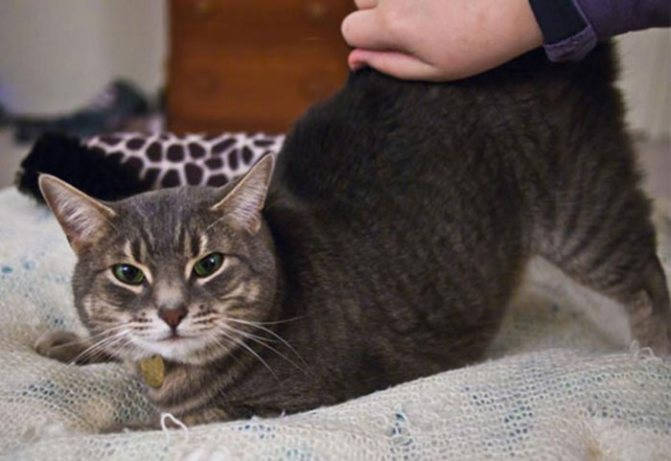
Pathological causes of tremors
Sometimes the body tremor is accompanied by secondary symptoms. The general health of the cat may suffer. In this situation, you can not do without the help of a veterinarian. What to pay attention to in such a situation and how to understand that your pet is not healthy?
Heatstroke
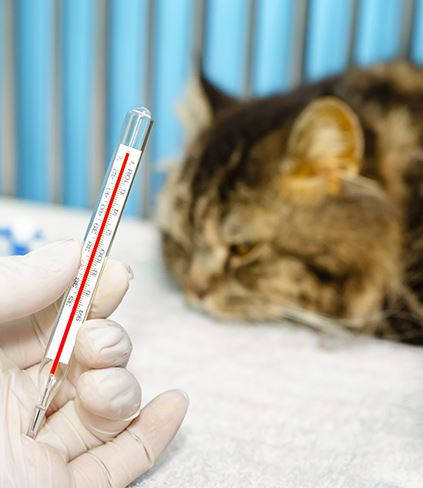
Increased body temperature in a cat can occur as a result of heat stroke. This condition usually occurs in the summertime.
In addition to the tremor, the pet may have symptoms such as:
If there is a high fever, it is important to get the pet to a clinic as soon as possible. To reduce the fever, wet towels can be placed under the cat. It is very important to ensure that the cat has a full drinking regimen. Water can be injected into the mouth with a syringe.
Viral and bacterial diseases
Tremor can accompany diseases such as rhinotracheitis or calicivirosis.
Antibiotics and antiviral drugs are used for treatment. A sick animal is isolated from healthy animals. The duration of therapy is determined individually.
Parasite infestation
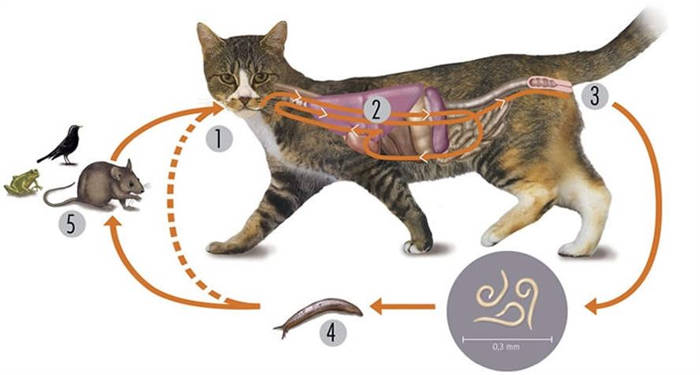
Advanced worm infestations are the cause of severe intoxication of the cat's body. Body shivering can be a reaction to the presence of worms. Most often, cats suffer from cestodes, ascarids, nematodes.
Worm infestations are treated medically. Pills, injections or suspensions are used for this purpose. It is also necessary to carry out regular prevention of parasites, especially if the cat is outdoors.
Vitamin and micronutrient deficiencies
Shivering can indicate a deficiency of B vitamins and calcium. As a result of the deficiency there are degenerative processes in the muscle tissue, which provokes the development of tremor. Vitamin deficiencies can be determined with a general blood test. To solve the problem, the cat is prescribed special vitamins, medications or special food.
When to go to the vet
When the cat trembles as a result of a pathological condition and the tremor is not related to physiological processes, it is imperative to show the pet to a veterinarian. This will allow you to quickly identify the cause of the pathology and prescribe an adequate and appropriate treatment.
Quite common pathologies diagnosed in domestic cats in veterinary medicine are:
- The cat shakes with small shakes due to herpesvirus infection or rhinotracheitis virus. In addition to shivering, the cat will have discharge from the eyes and respiratory tract, a characteristic cough and episodes of gastric contents eruption.
- The cat trembles with the whole body In helminthiasis, life-threatening for the animal. Infection with dangerous helminths is accompanied by processes of intoxication of the body, provoking the development of tremors. In some cases, the tremor is not observed in the entire body, but only in the hind or forelimbs.
- Inflammatory process in the bladder.Cystitis causes painful sensations during the act of urination, which leads to tremors of pain. The same symptom appears in domestic cats when they develop urolithiasis .
- Diseases of the ears – Otitis and otodectosis of various kinds may cause itching and discomfort to the cat, resulting in tremors (cat's head shaking). If not treated promptly, the pet can lose its hearing, and in the most dangerous cases, when the eardrum ruptures due to bacterial otitis media, the brain membranes can become infected.
- The appearance of tremors in the head area , may not only indicate a lesion of the ear canal. As a rule, the cause of head tremor and trembling in the body may be encephalitis, cerebellar pathology, dangerous skull injuries.
- Tremors in the sacral region The tremor may be a signal of spinal abnormalities caused by compression fractures, tumor processes, deformities in the intervertebral discs.
Pain
Cats are rather secretive animals, so they do not always show their owners if they feel discomfort.
But in some cases, experiencing severe pain, the pet may begin to tremble. In addition to pain, intoxication and shock can cause shivering.
It is important to seek help from a veterinarian in a timely manner, especially if symptoms other than body shivering are noted. The doctor will help find out the cause of the pathological process and prescribe adequate treatment.
Fever
The fact that the cat is sick is indicated by other symptoms besides shivering:
Systemic intoxication of the body is characterized by a gradual increase in the amplitude of tremor in the muscle fibers. This is due to the fact that toxic substances enter the blood in portions. The first muscle contractions are weak, but soon there is an increase. If the pet is not helped in time, it can be fatal. Before death, the cat may experience convulsions .
Biochemical processes occurring in the cat's body can cause tremors in the body. During sleep, internal organs continue to function, which in turn is manifested by tremors in parts or the entire body. A triggering factor can be:
Shivering is part of the norm in animals after surgery. When coming out of anesthesia, the body is trying to cope with residual substances. Noticing that the cat trembles for more than 6 consecutive hours after anesthesia, the owner should seek help from the veterinarian. The cause of prolonged tremor may be internal hemorrhage.






